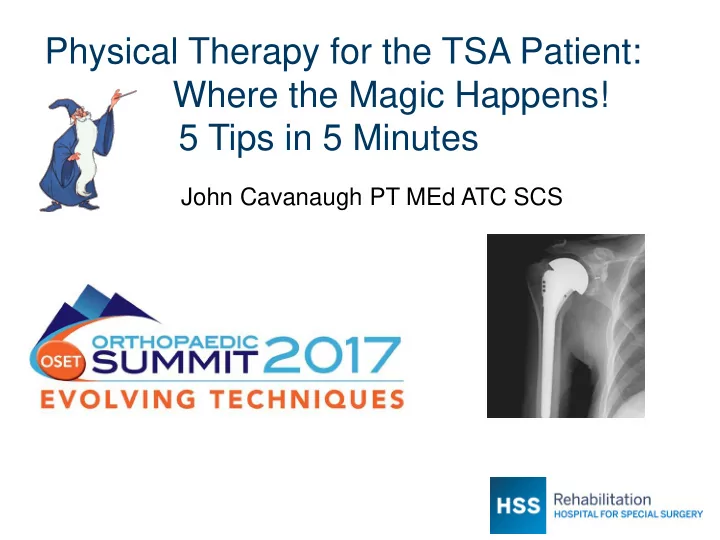

Physical Therapy for the TSA Patient: Where the Magic Happens! 5 Tips in 5 Minutes John Cavanaugh PT MEd ATC SCS
John Cavanaugh, PT, MEd, ATC, SCS Presentation will not include the discussion of commercial products or services and he does not have significant financial interest or relationship with the manufacturers of products or services Presentation will not include discussion of off label or investigational use of products or treatments
Total Shoulder Arthroplasty TSA not a THA not a TKA Technically challenging procedure for the Surgeon Equally challenging for the Physical Therapist
Communication Tip #1 Surgeon ↔ Patient MD Therapist ↔ Patient Surgeon ↔ Therapist – Surgical Procedure PT Patient – Quality of Bone & Soft Tissue (RC)
Avoid the “Dreaded” Subscap Rupture…” Simulation Physical Therapy Initial Evaluation 64y/o Male S/P R TSA 17 days ago 5
Who’s to Blame ? Surgeon Therapist Patient 6
How do we Prevent this ? Patient Education Pre-operative physical therapy visit Pathway to recovery book Instruct in sling use Goals/Expectations Precautions* Overview of exercise program Assess ROM and Strength Assess current ADL function (DASH) 7
Create a Safe Environment Tip #2 Prequisites include: Knowledge of: Post-Op Restrictions Surgeon’s Prescribed Guideline e.g. Aquatic therapy (Speer, Cavanaugh, et al AJSM ’93) – Re-education for dyssynergic shoulders – Adjunct to traditional therapeutic exercise – Proprioceptive input
“Don’t Hurt the Patient” Tip #3 Facilitate ROM Soft Tissue Massage Exercise Repetition
“Don’t Let the Patient Hurt the Patient” Tip #3b Limited # of hours with PT Insurance issues
Hours / Week Therapy 2% Non- Therapy 98% 11
Follow a Functional Progression of Therapeutic Exercises Tip #4 Range of Motion (Scapular Plane) PROM AAROM External Rotation Elevation Internal Rotation
Functional Progression Strengthening Scapular MM Deltoid Rotator Cuff 13
Functional Progression Strengthening Scapular MM Deltoid Rotator Cuff 14
Functional Progression Strengthening Scapular MM Deltoid Rotator Cuff 15
Criteria Based Guideline Tip #5 vs “Protocol” Allows for Individualization Respect Timeline Advance upon meeting criteria
Total Shoulder Arthroplasty: Treatment Strategies: Post-OP Week 0-4 Criteria for Advancement: Pain controlled Range of motion, elevation to 120°, external rotation to 30° Independent light activities of daily living Independent home exercise program 17
Utiilization of these Tips of Rehabilitation can contribute to a successful outcome Patient Education is key Follow a Functional Progression throughout the rehab course Advance via a criteria based guideline respecting timelines Return to Sport is attainable with modifications 18
Thank You 19
Recommend
More recommend